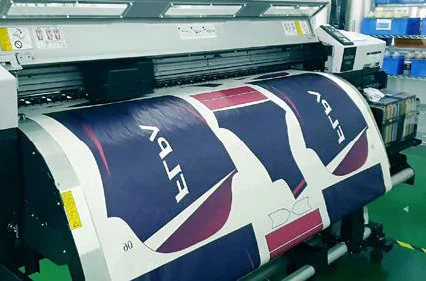From Traditional to Digital: Understanding the Advancement of Cloth Printing
The makeover of cloth printing from standard approaches like block printing and resist dyeing to contemporary methods such as display and digital printing notes a significant shift in the textile market. Standard approaches, soaked in artisanal workmanship and cultural value, have slowly paved the way to digital technologies that supply unprecedented precision, performance, and modification. This transition not only enhances production capabilities but also aligns with growing demands for sustainable practices. Yet, exactly how do these developments impact the significance of fabric printing, and what might the future hold for this ever-evolving craft?
Standard Fabric Printing Methods
In the early phases of textile manufacturing, traditional cloth printing techniques served as the foundation of fabric style, supplying both performance and imaginative expression. Block printing, one of the oldest approaches, involved carving detailed designs into wood blocks, which were then dipped in dye and pushed onto textile.
Withstand dyeing, consisting of techniques like batik and tie-dye, employed wax or various other materials to avoid dye from passing through certain areas of the material. This approach developed striking contrasts and elaborate styles, usually imbued with cultural relevance. Stenciling, an additional traditional method, included reducing patterns right into a product and using color through the openings, providing an easier yet efficient means to generate recurring designs.
These traditional techniques not just formed the textile sector's very early growth but also laid the groundwork for future advancements. Each strategy showed the local and cultural attributes of its beginning, protecting and sharing artisanal expertise via generations.
The Increase of Display Printing
Exactly how did screen printing transform the landscape of textile layout? The arrival of display printing in the very early 20th century marked a considerable departure from conventional methods, providing unmatched adaptability and effectiveness. This method includes pushing ink via a great mesh screen that has been stenciled with a design, permitting for high accuracy and consistency. Screen printing made it possible for developers to create elaborate patterns and vibrant shades on textiles, which were previously challenging to attain with block printing or hand-painting techniques.
One of the key benefits of screen printing is its capacity to reproduce complicated layouts widespread with exceptional fidelity. This scalability made it immensely preferred in the commercial fabric industry, where automation without sacrificing top quality is critical. In addition, screen printing suits a variety of inks and dyes, broadening the scheme of appearances and coatings offered to developers.
Furthermore, the process is very versatile, suitable for different textile kinds including cotton, silk, and synthetics. This versatility, incorporated with its cost-efficiency for huge runs, solidified screen printing's function as a keystone of modern-day textile manufacturing. Thus, the surge of screen printing transformed the market, pressing the borders of what was feasible in fabric layout.

The Advent of Digital Printing
Building on the amazing improvements brought by display printing, the fabric market experienced one more groundbreaking advancement with the development of electronic printing. Arising in the late 20th century, electronic printing transformed the way designs are transferred onto fabrics, supplying unprecedented versatility and effectiveness. Unlike standard techniques, which commonly needed substantial configuration and considerable hands-on intervention, digital printing uses computer-aided layout (CAD) modern technology to create complex patterns directly onto the fabric with high accuracy.
This technology has actually allowed textile manufacturers to fulfill the expanding demand for customization and on-demand production. By removing the requirement for plates and displays, electronic printing lessens and decreases lead times material waste, making it an extra sustainable alternative. The capability to print intricate pictures and a large range of colors in a single pass has actually opened brand-new creative methods for designers, fostering a rise in artistic expression within the sector.
Moreover, electronic printing supports smaller sized batch manufacturing runs, which is especially advantageous for particular niche markets and startup style brands. This technical leap has not just enhanced functional efficiency however also democratized accessibility to top notch textile printing, establishing the stage for future technologies in material style and manufacturing.
Comparing Strategies: Traditional Vs. Digital
While both electronic and traditional printing techniques have their very own unique advantages, they vary substantially in terms of procedure, efficiency, and environmental effect. Typical cloth printing, including strategies like block printing and screen printing, includes hands-on labor and elaborate craftsmanship. These techniques are commemorated for their capacity to produce rich structures and vivid colors, often resulting in special, artisan-quality items. They are labor-intensive, taxing, and often limited in terms of color range and style complexity. my website
In comparison, digital printing uses sophisticated technology to move designs straight onto fabric making use of inkjet printers. Digital printing is substantially faster, enabling for quick turn-arounds and just-in-time production, which minimizes the need for big inventory storage.
From an ecological point of view, electronic printing is typically extra sustainable. It makes use of less water and creates marginal waste compared to standard methods, which commonly involve substantial cleaning and dyeing procedures. Electronic printing is increasingly favored in an age web where ecological factors to consider are vital.
Future Trends in Towel Printing
One substantial fad is the raised application of electronic printing modern technologies. Digital fabric printing is anticipated to control the market, driven by its effectiveness and flexibility to customer needs for customized and limited-edition products. Branded clothing.

Furthermore, the consolidation of clever textiles, which incorporate electronic elements right into materials, is readied to transform the marketplace. These textiles can supply extra performances such as temperature level law, health tracking, and interactive attributes. As innovation remains to advance, the crossway of electronic printing and clever textiles will certainly open up brand-new avenues for imaginative and useful applications in towel printing.
Final Thought
The advancement of towel printing from conventional techniques to electronic innovations marks a considerable makeover in the fabric industry. While conventional methods highlight artisanal workmanship and social heritage, electronic printing supplies exceptional accuracy, performance, and modification. This change not just enhances production capabilities but also supports sustainability efforts. Future patterns are most likely to proceed incorporating innovative modern technologies, Discover More better redefining fabric layout and manufacturing procedures to fulfill ecological factors to consider and modern demands (Branded clothing).
The makeover of fabric printing from conventional approaches like block printing and withstand coloring to modern methods such as screen and electronic printing marks a considerable shift in the fabric industry. Display printing enabled developers to create intricate patterns and lively colors on materials, which were previously testing to achieve with block printing or hand-painting techniques.
Building on the exceptional advancements brought by display printing, the fabric market experienced an additional groundbreaking development with the development of digital printing. heat transfer vinyl printing. Conventional towel printing, encompassing strategies like block printing and screen printing, includes hand-operated labor and intricate craftsmanship. As modern technology continues to advancement, the junction of digital printing and wise fabrics will certainly open new opportunities for practical and imaginative applications in cloth printing
 Elin Nordegren Then & Now!
Elin Nordegren Then & Now! Marcus Jordan Then & Now!
Marcus Jordan Then & Now! Karyn Parsons Then & Now!
Karyn Parsons Then & Now! Shannon Elizabeth Then & Now!
Shannon Elizabeth Then & Now! Batista Then & Now!
Batista Then & Now!